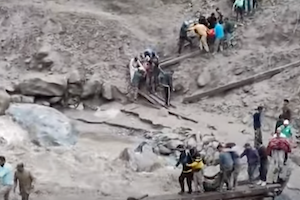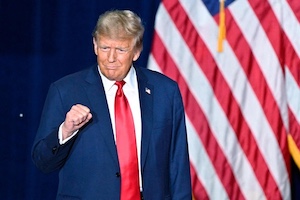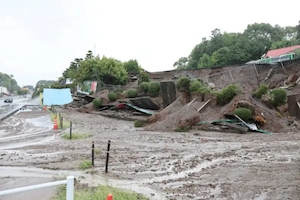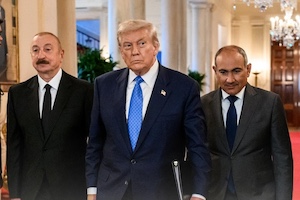World
European Leaders Issue Joint Statement After US-Russia Summit: Ukraine Must Have "Ironclad Security Guarantees"

After the U.S.-Russia summit concluded, despite lengthy talks between Donald Trump and Vladimir Putin, the two sides failed to reach a ceasefire agreement in the Russia-Ukraine war. Trump later wrote that the best way to end the war was not a ceasefire, but a “direct peace agreement,” stressing that his calls with President Zelensky and European leaders “went very well.” Ukrainian President Zelensky expressed support for Trump’s idea of a “U.S.-Ukraine-Russia trilateral meeting” and announced that he would travel to Washington on the 18th to meet with Trump to discuss concrete plans to end the war. Trump revealed that if progress goes smoothly, the next step would be arranging another meeting with Putin, emphasizing that “this could save millions of lives.”
Following the U.S.-Russia summit, leaders of major European nations quickly issued a joint statement, reaffirming their steadfast support for Ukraine and commitment to its security. The statement was signed by French President Emmanuel Macron, Italian Prime Minister Giorgia Meloni, German Chancellor Friedrich Merz, U.K. Prime Minister Keir Starmer, Finnish President Alexander Stubb, Polish Prime Minister Donald Tusk, European Council President António Costa, and European Commission President Ursula von der Leyen. The statement stressed that Ukraine must have “ironclad security guarantees,” that its military capabilities and international cooperation should not be restricted, and that Russia has no right to veto Ukraine’s accession to the EU or NATO. European leaders unanimously declared that international borders cannot be changed by force, pledging to continue strengthening sanctions on Russia and imposing broader economic measures until a just and lasting peace is achieved.
European leaders also voiced public support for Ukraine. U.K. Prime Minister Keir Starmer praised Trump’s diplomatic efforts on social media, saying they had brought the end of Russia’s illegal war “closer than ever,” while stressing that no negotiations could bypass Zelensky. He welcomed U.S. and European security guarantees and reiterated that Europe would continue to escalate sanctions until Putin ends his aggression. French President Emmanuel Macron stated that in the face of Russia’s ongoing aggression, Europe must stand firm in supporting Ukraine and maintaining pressure on Moscow. He emphasized that peace must be built on “robust security guarantees,” and reminded the international community of Russia’s repeated failures to honor its commitments over the past 30 years, reaffirming that France would “stand firmly alongside Ukraine.”
- 33 reads
Putin Proposes Ceasefire Terms: Land-for-Peace Deal and Frozen Frontlines

In a recent summit held in Alaska between Donald Trump and Vladimir Putin, the Russian president proposed conditions to end the Russia-Ukraine war. The core of the proposal requires Ukraine to relinquish control over its eastern territories in exchange for Russian forces freezing other frontlines.
According to reports from the Financial Times, The Guardian, and Reuters, Putin’s terms include Ukraine’s full withdrawal from Donetsk and Luhansk as a precondition for a ceasefire and peace talks. In return, Russia would agree to freeze its positions in Kherson and Zaporizhzhia and halt further advances.
Following the talks, Trump swiftly shifted away from his long-standing call for an “immediate ceasefire,” instead naming a “Peace Agreement” as the preferred solution. He argued that this would bring a definitive end to the conflict, unlike ceasefire deals that often “collapse and reignite.” Trump even disclosed that he had told President Zelensky that Putin would only negotiate peace if Ukraine surrendered the Donbas region, while the U.S. could potentially provide security guarantees in exchange.
Ukrainian President Volodymyr Zelensky responded firmly, stressing that Kyiv would never concede and would defend its territorial integrity. He insisted that any negotiations must begin with a ceasefire, and that territorial issues could only be discussed with Ukraine’s full participation.
European allies voiced support for Zelensky’s stance, underscoring that Ukraine’s borders cannot be altered by force and calling for a ceasefire and negotiation framework that includes binding security guarantees and legal safeguards.
Beyond the territorial exchange, reports suggested that Putin presented broader demands: a written Western commitment to halt NATO’s eastward expansion, partial lifting of sanctions on Russia, recognition of Russian language and cultural rights, and protections for Russian-speaking communities within Ukraine. Other sources indicated that Putin’s ultimate objective is full control of Donetsk, Luhansk, Zaporizhzhia, and Kherson before pursuing a comprehensive peace deal.
The U.S.-Russia summit ended without any substantive agreement. Putin walked away without making major concessions, while Trump’s policy shift drew sharp concern from Europe and Ukraine. Critics warned that Trump’s approach risked handing Russia a significant political victory while undermining Ukraine’s position. The Financial Times even described Ukraine as feeling “betrayed,” accusing Trump of supporting a plan that effectively sells out years of Ukrainian resistance.
Observers believe Zelensky will not accept the loss of Donetsk, though he remains open to discussing territorial matters with Trump. Zelensky is scheduled to meet Trump in Washington on the 18th. The White House has declined to comment on reports about the Trump-Putin talks.
With negotiations stalled, media outlets and think tanks suggest two possible scenarios ahead:
“Partition with Protection” — Ukraine is unable to reclaim all its lost territory, but a peace agreement freezes the current frontlines, with Western security guarantees protecting its remaining sovereignty.
“Partition with Subordination” — Weakened by military strain and domestic fatigue, Ukraine may be forced into becoming a client state under Russian influence, losing genuine independence.
- 35 reads
Heavy Rain in Kashmir, India: Flash Floods Sweep Away Pilgrims, 56 Dead, Over 200 Missing

On August 14, heavy rainfall suddenly struck the Kashmir region of India, triggering landslides and flash floods. The disaster has resulted in more than 56 deaths and at least 200 people reported missing, marking the second deadly flash flood to hit the Indian Himalayas since August.
The incident occurred in the town of Chasoti, located in the Kishtwar district, which serves as a key rest stop along a popular pilgrimage route. At the time, torrential rain destroyed the rest area in Chasoti where more than 200 pilgrims were gathered for a meal. The sudden floodwaters swept many of them away. Upon receiving reports, rescue teams along with military and police forces rushed to the scene to carry out search and rescue operations, combing through debris in search of survivors.
This year’s pilgrimage was originally scheduled to run from July 25 to September 5. However, due to this deadly flood, the local government has ordered all activities to be suspended. Indian Prime Minister Narendra Modi expressed condolences to the victims and pledged full support for disaster relief efforts.
The meteorological department has forecast continued heavy rainfall in the coming days, warning of potential further landslides and flash floods.
- Read more
- 36 reads
Emergency Evacuation in Juneau, Alaska Due to Glacier Melt Causing Downstream Flooding

Juneau, the capital of Alaska, has issued an emergency evacuation after flooding was triggered by the melting of the Mendenhall Glacier. The rapid melt caused water levels in Mendenhall Lake and Mendenhall River to surge, leading to a breach on the 13th. Meltwater flooded into streets and residential areas, prompting residents to evacuate. Climate change and glacier melt, driven by global warming, have made the Juneau area—located adjacent to Mendenhall Lake—face annual flood threats during the spring and summer seasons.
Dr. Eran Hood, an environmental science professor at the University of Alaska Southeast, stated that data shows floods from the Mendenhall Glacier have occurred annually since 2011, with the severity increasing over the past three years. The Mendenhall River, which normally has a depth of just 6 feet, reached 14.97 feet during the 2023 flood. In August last year, the river rose to 15.99 feet, submerging over 100 homes in the Mendenhall River Valley. Meteorologist Nicole Ferrin from the National Weather Service predicts that this year the river may rise to 16.6 feet.
Dr. Hood explained that the Suicide Glacier, located upstream of the Mendenhall Glacier, has now melted and left behind a basin. This basin collects rainwater, snowmelt, and glacial meltwater, effectively forming a dam. Water from the basin seeps underneath and overflows above the glacier, accelerating the melting of the Mendenhall Glacier and causing further downstream flooding.
- Read more
- 29 reads
Tracking the flow of AI chips: U.S. authorities secretly embed tracking devices during server exports.

As the U.S. Department of Commerce tightens its export restrictions on AI chips to China, lawmakers in both chambers of Congress have continued to push legislation aimed at tracking the location of AI chips to prevent them from being re-exported to China. Although the U.S. has eased restrictions on Nvidia’s H20 chips, Reuters reported that the U.S. government has quietly embedded tracking devices into certain high-risk AI chips to monitor their flow.
Citing two sources familiar with the matter, Reuters reported that the U.S. has long been installing tracking devices in shipments of advanced chips it suspects could be illegally diverted to China. The goal is to monitor specific shipments under investigation to determine whether they are re-exported to regions under U.S. export restrictions. This enables authorities to prosecute companies or individuals who profit from violating U.S. export controls. Such tracking devices have long been used by U.S. law enforcement agencies to track export-controlled items like aircraft parts, weapons, and narcotics.
Several insiders from the server product supply chain also revealed that they have seen U.S. authorities use trackers in shipments from companies such as Dell and Super Micro. These trackers were primarily used to trace Nvidia and AMD chips embedded in the products. However, there is no clear information on which agencies installed the devices or when. Some of the trackers are as large as a smartphone, while others are compact location beacons. Although installing trackers in shipment packages typically requires a court order, export enforcement personnel can sometimes proceed with only administrative approval.
Reuters noted that the Bureau of Industry and Security (BIS), which is responsible for export controls and enforcement under the U.S. Department of Commerce, typically participates in these investigations. The Department of Homeland Security’s Homeland Security Investigations (HSI) and the Federal Bureau of Investigation (FBI) may also be involved. All three agencies declined to comment.
Among the vendors, Super Micro stated in a press release that the company strictly implements security policies designed to protect global operations, partners, and customers. Dell said it was unaware of the program, while Nvidia has not commented or responded.
- Read more
- 103 reads
Trump Cracks Down on Homelessness, Deploys National Guard to Washington, D.C.

U.S. President Donald Trump recently announced a large-scale crackdown on homelessness and crime in Washington, D.C., deploying the National Guard to the capital in a move he says is aimed at restoring “law and order.” The decision has sparked fierce backlash from local authorities and civil rights groups, who criticize it as an unprecedented expansion of federal power.
Trump posted on social media, stating that the homelessness crisis and deteriorating public safety in D.C. have severely damaged the nation’s image and security. He stressed the need to “immediately clear the streets of tents and drugs.” He added that the homeless would be relocated to shelters outside the city center, and those who refuse may face arrest.
A White House spokesperson later confirmed that Trump had invoked provisions of the *District of Columbia Home Rule Act* to place the D.C. police under the command of the U.S. Department of Justice. Approximately 800 National Guard troops have been deployed to assist with enforcement. On the first day of the operation, federal and local officers arrested more than 20 individuals on charges including firearms possession, drug offenses, violence, and drunk driving, and confiscated several illegal weapons.
Trump declared this was “the first step in taking back the capital,” saying cleanup efforts will continue over the coming weeks, with intensified crackdowns on drugs, gangs, and undocumented immigrants. He criticized past local administrations for “tolerating chaos,” which he claimed left the areas around Congress and major streets “dangerous and filthy.”
However, D.C. Mayor Muriel Bowser strongly objected to the move, pointing out that violent crime in the city has already dropped by over 20% this year and is now at its lowest level in 30 years, showing no security crisis that would justify federal intervention. She accused Trump of disregarding local autonomy and using the capital as a political stage.
Several legal experts and civil rights organizations also warned that the move may violate constitutional protections for local self-governance and infringe on the rights of the homeless. The American Civil Liberties Union (ACLU) condemned the forced removals and arrests of unhoused individuals, saying it criminalizes poverty and does nothing to address root issues such as addiction and housing.
For now, tensions between federal and local governments continue to rise. The Trump administration insists the operation will proceed until the capital is “restored to order and dignity,” while opponents are threatening legal action to block the federal takeover and military deployment. The controversy, centered around public safety, poverty, and constitutional authority, is expected to ignite broader debate across American society.
- 43 reads
Record-Breaking Torrential Rain Batters Kumamoto, Forcing 1,600 to Evacuate

On the 11th, Japan’s Kyushu region was hit by an unusually severe rainstorm, with Kumamoto Prefecture’s Tamana City recording more than 370 millimeters of rainfall in just six hours — the highest total ever observed in the area. The Japan Meteorological Agency (JMA) issued an emergency heavy rain special warning, rapidly expanding the alert zone to Yatsushiro City, Uki City, and surrounding areas. Authorities urged residents to take the highest level of evacuation precautions, warning that “there is an imminent threat to life.” Kumamoto Prefecture’s Disaster Response Headquarters was established in the early hours of the 11th, and as of 11 a.m., 743 households — a total of 1,694 people — had been evacuated. Multiple urban roads were submerged, cars stranded, buildings inundated, and basement flooding widely reported. Even the famous Shimotori covered shopping street was engulfed by floodwaters.
The torrential downpour triggered multiple mudslides and flash floods, leaving at least one person dead and several others missing. In Kōsa Town, a vehicle carrying evacuees was struck by a landslide — a mother and her two children were rescued, but the father remains missing. In Misato Town, a home was buried by debris, trapping residents who remained conscious. Tamana City also received reports of people being swept away by floodwaters. Meanwhile, in Fukutsu City, Fukuoka Prefecture, the Saigo River overflowed, sweeping away a man and a woman in their 60s, with search operations still underway. Rescue efforts have been hampered by blocked roads, making evacuation extremely difficult.
The JMA reported the formation of linear rainbands over Kumamoto and Nagasaki, with heavy rains expected to continue through the 12th. Multiple rivers in northern Kyushu and Yamaguchi Prefecture have already exceeded flood danger levels, and a level-3 equivalent flood warning has been issued for the Nibo River in Yamaguchi City. JR Kyushu announced the suspension of all Shinkansen services on the 11th, leaving large numbers of passengers stranded at stations. The JMA urged residents in hillside, riverside, and low-lying areas to evacuate immediately. If roads are impassable, they advised moving to higher floors in nearby buildings and taking protective measures to maximize safety. Confronted with yet another extreme weather disaster, Japanese society is once again facing a severe test.
- Read more
- 54 reads
European Leaders Reject Trading Ukrainian Territory for Peace, Zelensky Voices Strong Support 詢問 ChatGPT

Ukrainian President Volodymyr Zelensky on the 10th stressed that the Kyiv government “highly values and fully supports” the joint statement issued by several European leaders to promote peace in Ukraine and safeguard the interests of both Ukraine and Europe.
According to Reuters, the leaders of France, Italy, Germany, Poland, the United Kingdom, Finland, and the European Commission on the 9th expressed their welcome for U.S. President Donald Trump’s efforts to help end the Russia–Ukraine war, while also emphasizing the need to maintain pressure on Russia and provide Ukraine with security guarantees.
In a post on social media platform X, Zelensky said the war must end in a just manner. He thanked all the nations and peoples standing with Ukraine and fighting for peace, stressing that Ukraine is protecting vital security interests for all of Europe. He also extended individual thanks to French President Emmanuel Macron, Italian Prime Minister Giorgia Meloni, German Chancellor Friedrich Merz, Polish Prime Minister Donald Tusk, British Prime Minister Keir Starmer, European Commission President Ursula von der Leyen, and Finnish President Alexander Stubb for their support of Ukraine.
Trump is scheduled to meet Russian President Vladimir Putin in Alaska on the 15th of this month, claiming that the talks could lead to an agreement to end the three-and-a-half-year-long conflict. However, Zelensky and European allies have made it clear that any proposal requiring Ukraine to cede large swathes of territory would only serve to fuel Russia’s expansionist ambitions.
- 33 reads
Apollo 13 Commander Jim Lovell Dies at 97

Jim Lovell, a renowned American astronaut, passed away on the 7th at the age of 97. He was best known as the commander of the famous Apollo 13 mission, which was later adapted into a film in which Tom Hanks portrayed him.
NASA announced that Lovell died on the 7th in Lake Forest, Illinois. The agency said his steadfast character and courage helped America reach the Moon and turned what could have been a tragedy into a success. “We mourn his passing and honor his remarkable achievements,” NASA stated.
Lovell commanded the historic Apollo 13 lunar mission in 1970. When the spacecraft was about 200,000 miles from Earth, an oxygen tank in the service module exploded, putting the three astronauts’ lives in grave danger. The crew used the lunar module as a makeshift lifeboat and, after a tense three-day journey, successfully returned to Earth. The mission became known as NASA’s “most successful failure,” and Lovell’s calm report to Mission Control — “Houston, we’ve had a problem” — became an iconic phrase.
In 1995, the film Apollo 13 was released, with Tom Hanks playing Lovell. In the movie’s closing scenes, after the astronauts’ safe return to Earth, the captain of the USS Iwo Jima — the amphibious assault ship sent to recover them — was portrayed in a cameo by Lovell himself.
On Instagram, Tom Hanks mourned his passing: “Some men dare to challenge, dare to dream, and lead others to places we cannot reach alone. Jim Lovell was such a man. He explored space longer and farther than anyone else on Earth.”
Lovell was a member of America’s early space program, flying on multiple space missions. With over 715 hours in space, he once held the record for the longest total time spent in space and still holds the record for the farthest distance humans have traveled from Earth. Despite flying on two lunar missions, he never set foot on the Moon. Following the Apollo 13 mission, Lovell was awarded the Presidential Medal of Freedom in 1970, retired from the U.S. Navy and NASA in 1973, was inducted into the U.S. Astronaut Hall of Fame in 1993, and received the Congressional Space Medal of Honor from President Bill Clinton in 1995.
- Read more
- 32 reads
Trump Hosts Armenia-Azerbaijan Peace Summit

On August 8, U.S. President Donald Trump hosted a peace summit between Azerbaijan and Armenia at the White House. Azerbaijani President Ilham Aliyev and Armenian Prime Minister Nikol Pashinyan signed a peace agreement, officially ending 35 years of conflict and hostility between the two nations. Following the summit, both leaders praised President Trump for his contributions to ending the conflict and announced plans to jointly nominate him for the Nobel Peace Prize.
Since the Soviet era in the 1980s, Armenia and Azerbaijan have been in a state of opposition due to the territorial dispute over Nagorno-Karabakh. The two countries have fought two wars over the region. In September 2020, war broke out again over the control of Nagorno-Karabakh. Azerbaijan utilized a large number of suicide drones during the conflict and successfully regained control of the region. The prolonged fighting over the years resulted in thousands of casualties. Although several world leaders attempted to broker peace, none were successful until Trump’s envoy, Steve Witkoff, visited Azerbaijan earlier this year. Continuous negotiations and mediation led to the eventual agreement.
Trump stated that the peace agreement signed by Armenia and Azerbaijan commits both parties to cease hostilities and establish diplomatic relations based on mutual respect for territorial integrity. The agreement includes expanding cooperation in energy, trade, and artificial intelligence, as well as opening a transportation corridor connecting Azerbaijan with its exclave, Nakhchivan. This corridor, which spans 32 kilometers through Armenian territory, will be developed by private enterprises to include railway lines, oil and gas pipelines, and fiber-optic networks. It will be named the *Trump International Road of Peace and Prosperity*.
In addition, the United States signed agreements with both Armenia and Azerbaijan granting the U.S. exclusive development rights to a strategic transit corridor through the South Caucasus. The agreements also lift restrictions on U.S.-Azerbaijan defense cooperation. Furthermore, the U.S. will sign bilateral agreements with both countries to further promote infrastructure development in transportation and energy.
- Read more
- 31 reads
Human Rights
Fostering a More Humane World: The 28th Eurasian Economic Summi

Conscience, Hope, and Action: Keys to Global Peace and Sustainability

Ringing FOWPAL’s Peace Bell for the World:Nobel Peace Prize Laureates’ Visions and Actions

Protecting the World’s Cultural Diversity for a Sustainable Future

Puppet Show I International Friendship Day 2020

